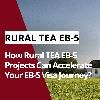Fast-Track Your EB-5 Visa Process Through Target Employment Area (TEA EB-5)
Accelerate your EB-5 visa with Targeted Employment Areas (TEAs). Identify qualified TEAs for faster visa approvallast updated Friday, January 16, 2026
#targeted employment area #targeted employment area list
| | by Sidra Jabeen | Content Manager, Paperfree Magazine |

QUICK LINKS
AD
Get Access to EB 5 Investment Visa Resources
The EB-5 Immigrant Investor Program, established by the United States Congress in 1990, offers foreign investors a unique pathway to U.S. residency through investment. The core objective of the EB-5 program is to stimulate the U.S. economy through job creation and capital investment by foreign investors. At the heart of this program lies the concept of Targeted Employment Areas (TEAs), which are pivotal in fostering economic growth in areas most in need.
Targeted employment areas are defined geographic regions that qualify for a lower investment threshold under the EB-5 program. These areas include specific rural regions and zones with elevated unemployment. Understanding targeted employment area list criteria and how designation works is essential for prospective investors evaluating eb 5 investment projects. This strategic aspect of targeted employment areas highlights their importance in directing capital into regions that benefit most from job creation and economic development.
The purpose of this article is twofold. First, we aim to demystify the concept of Targeted Employment Areas (TEAs), clarifying what qualifies as a TEA and why it matters to an EB-5 investor. Second, and most importantly, this blog seeks to assist prospective investors in making informed decisions. Understanding the nuances of TEA designation can be the key to a successful EB-5 investment, ensuring that your venture meets legal requirements and contributes meaningfully to the U.S. economy. To ensure you have complete guidance for your EB-5 visa journey, you may explore Paperfree’s detailed overview of the TEA framework here
Get Access to Fully Vetted EB-5 Targeted Employment Area Projects (TEA EB5)
Investing in EB-5 projects within Targeted Employment Areas (TEAs) provides significant benefits, including expedited visa processing and a lower investment threshold. Paperfree proudly offers two exceptional projects in rural TEAs, designed to help investors fast-track their journey to U.S. permanent residency. For a broader understanding of how EB-5 projects are structured, visit
Copper Valley Project
The Copper Valley project is located within a designated targeted employment area, structured to comply with EB-5 TEA qualification standards. The project aligns with the regulatory definition of a rural TEA and supports local economic development while meeting EB-5 job creation requirements. It represents a compliant eb5 rural tea investment opportunity based on current USCIS TEA eligibility criteria.
All Points North Project
The All Points North project, also located in a rural EB-5 TEA, is designed to foster innovation and economic development. Investing in this project offers the benefits of faster visa processing under the EB-5 program, ensuring a more efficient path to obtaining U.S. permanent residency.
These EB-5 projects illustrate how targeted employment areas are practically applied in compliant EB-5 investment projects, supporting both immigration objectives and economic development goals.
Why Invest in an EB-5 Targeted Employment Area (TEA)?
- Higher Approval Likelihood: Investing in a targeted employment area enhances the chances of EB-5 application approval. The U.S. government often prioritizes projects that funnel investments into areas most in need, favoring TEA projects during approval.
- Faster Visa Processing: Projects situated in a targeted employment area may benefit from visa set-aside categories introduced under the EB-5 Reform and Integrity Act, particularly for rural areas. This has made eb5 rural investment projects especially relevant for investors seeking more predictable processing timelines, subject always to USCIS workload and policy implementation.
- Reduced Investment Thresholds: targeted employment area allow for a lower investment amount, $800,000, as opposed to the standard $1,050,000 required for non-TEA projects. This lowered threshold makes the EB-5 program more accessible to a broader range of investors.
- Strategic Competitive Positioning: Selecting EB-5 investment projects in targeted employment areas allows investors to position themselves strategically within the program. It supports compliance with USCIS priorities while reducing capital exposure and aligning the investment with economic development goals in underserved regions.
What is a Targeted Employment Area (TEA) for EB 5 Investors?
Definition and Significance
A targeted employment area within the EB-5 Immigrant Investor Program refers to a geographic region officially designated for investment based on specific criteria. These criteria are designed to stimulate economic growth in areas that are either rural or experiencing high unemployment.
The significance of a targeted employment area lies in its direct impact on the required investment amount. While the standard EB-5 investment threshold is $1,050,000, projects located in a targeted employment area qualify for the reduced $800,000 level. This policy framework is what makes TEA designation a central component of many eb5 projects and eb 5 investment projects.
Why Targeted Employment Areas Matter
Projects located in targeted employment areas afford investors a reduced minimum investment amount of $800,000, compared to $1,050,000 for non-TEA projects. This reduction is codified in federal EB-5 policy and serves as a primary incentive for encouraging investment into regions with job creation needs.
Benefits of TEA designation include:
-
Lower capital requirement — supporting accessibility for a broader investor base
-
Alignment with economic policy — directing funds into areas with the greatest demand
-
Potential prioritization during adjudication — since TEA projects often meet program goals for job creation more readily
Types of Targeted Employment Areas
Rural Areas:
Rural TEAs are a major category within targeted employment areas. These are locations outside metropolitan statistical areas and outside any city or town with a population of 20,000 or more. Rural designation plays a critical role in eb5 rural tea investment planning because it opens access to both the reduced investment threshold and, under current law, visa set-aside availability for rural projects.
Rural-focused eb5 rural investment projects are structured to encourage economic development in regions that traditionally receive less private capital, supporting infrastructure development and sustainable employment.
High Unemployment Areas:
High unemployment areas qualify as a targeted employment area when the unemployment rate is at least 150% of the national average. These regions are sometimes referred to as a targeted unemployment area, and they represent a second major category of TEA eligibility.
Investments in these areas direct capital into communities facing significant employment challenges. As part of eb5 investment projects, high unemployment TEAs aim to maximize job creation impact while allowing investors to qualify under the reduced investment amount.
Criteria for EB-5 Targeted Employment Area 2024
Rural TEAs
Definition and Criteria:
Specific geographical and demographic criteria define Rural Targeted Employment Areas (TEAs). As determined by the Office of Management and Budget, a rural TEA must be located outside a metropolitan statistical area (MSA). Additionally, it must not be within any city or town with a population of 20,000 or more, according to the most recent decennial census. These criteria ensure that investments flow into areas that are truly rural, typically underdeveloped, and in need of economic stimulation. This definition follows the classification standards used by the U.S. Census Bureau and the Office of Management and Budget
Benefits and Challenges:
Investing in rural targeted employment areas offers significant benefits, such as contributing to the development of under-served regions and potentially higher rates of return due to lower initial investment requirements and less saturated markets. However, challenges include slower growth rates and limited market size, which affect the overall profitability and success of the investment. Investors must also deal with possible logistical issues, such as supply chain and transportation limitations in rural settings when reviewing eb 5 investment projects.
High Unemployment TEAs
Definition and Criteria:
High unemployment TEAs are designated when an area’s unemployment rate is at least 150% of the national average. These determinations rely on official labor market statistics published by the U.S. Bureau of Labor Statistic. This designation plays a critical role in forming a compliant targeted employment area list, as unemployment figures are updated regularly and TEA status can change accordingly. Projects qualifying under this category are often described as being located in a targeted unemployment area, which is a term frequently used in EB-5 planning discussions.
Benefits and Challenges:
The benefits of investing in high-unemployment TEAs include enhanced job creation potential and significant impacts on local communities. These investments can lead to revitalization and substantial economic improvement in areas that need it most. On the downside, such areas pose higher risks due to their economic hardships, potentially resulting in a slower return on investment. Additionally, investors may face challenges related to workforce availability and the need for additional training and education programs to ensure the local population meets job skill requirements.
Both types of TEAs play crucial roles in the EB-5 program, directing capital to where it can significantly impact American communities while providing investors with opportunities to participate in the U.S. economy at potentially lower costs and higher benefits. Understanding these criteria and the inherent advantages and challenges can help investors make more informed decisions and align their investment strategies with personal goals and broader economic needs.
Criteria for EB 5 Targeted Employment Area – Practical Considerations
Understanding the criteria for eb 5 targeted employment area qualification is essential for both investors and project developers. Whether a project qualifies through rural classification or unemployment data, documentation must be current, accurate, and supported by official government sources.
At this stage, investors evaluating eb-5 targeted employment area projects should confirm:
-
The geographic location satisfies rural or high-unemployment criteria
-
Supporting census or labor data is recent and verifiable
-
The project documentation aligns with USCIS filing requirements
This process directly impacts the reliability of any targeted employment area list used during project selection.
Process of Identifying and Verifying TEAs (EB5 Projects & TEA EB 5)
Determining TEA Status
Steps to Identify if a Project is in a Targeted Employment Area:
Identifying whether a project qualifies as being in a Targeted Employment Area (TEA) involves several key steps:
- Location Verification: The first step is to determine the project's geographical location and verify whether it lies within a rural area or an area with high unemployment. This typically involves referencing the latest census data for rural TEAs and labor statistics for high-unemployment TEAs.
- Data Collection: Collect relevant demographic and economic data from reliable sources, such as the U.S. Census Bureau and the Bureau of Labor Statistics, to support the TEA designation.
- Economic Analysis: Analyze the collected data to ascertain that the unemployment rate for high-unemployment TEAs is at least 150% of the national average or confirm the population criteria for rural TEAs.
- Mapping Tools: Utilize GIS mapping tools and other software to accurately delineate the boundaries of the proposed TEA and ensure the project's location qualifies.
Role of State Agencies and USCIS in Designation:
State government agencies play an important role by issuing letters or certifications confirming whether a geographic area qualifies as a TEA based on current data. These certifications form part of the documentation package submitted with EB-5 petitions.
However, final determination always rests with USCIS, which evaluates TEA evidence during the adjudication of each EB-5 petition. This process applies equally to projects marketed as eb5 tea, eb5 rural tea investment, or other eb 5 investment projects claiming TEA eligibility.
Verification and Documentation:
Necessary Documentation for Proving TEA Status:
To verify a project's TEA status, investors and developers must compile a comprehensive set of documents, including:
-
-
Official certification or support letters from state authorities
-
Unemployment statistics or rural classification evidence
-
Geographic and demographic reports
-
Mapping documentation showing project location boundaries
These documents collectively establish that the project is located within a legitimate targeted employment area and meets the criteria for eb 5 targeted employment area classification.
-
Best Practices for Ensuring Accuracy and Compliance:
Ensuring accuracy in the TEA designation process is critical for compliance with EB-5 regulations and the success of the investment. Best practices include:
- Regular Updates: Regularly update data and documentation to reflect current economic and demographic conditions, as TEA designations can change with new data releases.
- Third-Party Verification: Employ third-party experts or consultants to independently verify all data and documentation. This adds a layer of credibility and impartiality to the TEA designation process.
- Transparent Communication: Throughout the process, maintain clear and transparent communication with USCIS and state agencies to address any issues or queries regarding the TEA designation.
Advantages of Investing in TEA EB5
Reduced Investment Amount:
Reduced Investment Threshold for TEAs:
One of the primary advantages of investing in a Targeted Employment Area (TEA) is the reduced investment threshold. The EB-5 Immigrant Investor Program typically requires a minimum investment of $1,050,000 for projects not located in a targeted employment areas. However, for projects situated within a TEA, this requirement is significantly lowered to $800,000. This reduction is intended to incentivize investments into areas that are either rural or experiencing high unemployment, thereby directing capital to regions where it can have the most substantial economic impact.
Financial Implications for Investors:
The lowered investment threshold for TEA projects translates into substantial financial benefits for investors.
By investing $800,000 instead of the standard $1,050,000, investors can:
- Allocate their financial resources more efficiently, investing the saved amount in other ventures or diversification strategies.
- Access the EB-5 program with less capital, making it more feasible for a broader range of investors.
- Enhance their potential return on investment, as the initial outlay is lower, increasing the relative profitability of successful projects.
Increased Approval Rates:
Historical Data on Approval Rates for TEA Projects:
Historically, EB-5 projects in TEAs have experienced higher approval rates than their non-TEA counterparts. This trend can be attributed to the U.S. government’s priority in promoting economic development in areas that need it the most. Data from past years indicate that TEA projects are more likely to meet the job creation requirements and other program criteria, thus receiving favorable adjudication from the U.S. Citizenship and Immigration Services (USCIS).
How TEA Designation Affects Investor Confidence:
The higher approval rates associated with TEA projects significantly boost investor confidence. When investors see a consistent track record of successful applications and approvals for TEA projects, they are more likely to:
- Choose TEA projects over non-TEA projects, considering the higher likelihood of meeting the program’s requirements.
- You can trust in the investment's stability and reliability, knowing that it aligns with the government’s economic priorities.
- Feel assured about the potential for a smoother and faster approval process, reducing uncertainties and anxieties related to the lengthy EB-5 visa application timeline.
By understanding and leveraging these advantages, investors can make more informed and strategic decisions, aligning their financial goals with the opportunities presented by TEA projects. The reduced investment amount and increased approval rates make TEA investments a compelling option for those seeking to benefit from the EB-5 Immigrant Investor Program while contributing to meaningful economic development in the United States.
Challenges and Risks Associated with TEAs
Economic Risks
Potential Economic Challenges in Rural and High Unemployment Areas:
Investing in Targeted Employment Areas (TEAs) comes with inherent economic risks, mainly due to the nature of these areas:
- Rural Areas: These regions often need faster economic growth, more infrastructure, and reduced market access. The smaller population size can lead to lower consumer demand and workforce availability, impacting the overall success of an investment project. EB5 rural investment aims at strategic economic growth in rural areas.
- High Unemployment Areas: These areas may have systemic economic issues contributing to high unemployment rates, such as declining industries, poor infrastructure, and inadequate educational facilities. These factors can pose significant challenges to achieving the job creation targets required by the EB-5 program.
Mitigation strategies include:
To mitigate these economic risks, investors can adopt several strategies:
-
Comprehensive financial due diligence
-
Diversification across multiple eb 5 investment projects
- Partnerships with Local Entities: Collaborate with local businesses, government agencies, and community organizations to leverage their knowledge and resources and ensure better integration and support for the project.
- Contingency Planning: Develop robust contingency plans to address potential economic downturns or unforeseen challenges, ensuring the project remains viable under various scenario Before proceeding, investors should review Paperfree’s structured guidance on due diligence:
Project Viability
Assessing the Viability of Projects in TEAs:
Evaluating the viability of investment projects in TEAs is crucial to minimizing risks and maximizing returns. Critical steps in this assessment include:
-
-
Market demand and sustainability
-
Financial projections based on realistic assumptions
-
Job creation capacity that satisfies EB-5 requirements
-
Local government and community support
Strong projects within targeted employment areas demonstrate balanced risk management, transparent reporting, and sound economic fundamentals.
-
Key Factors to Consider:
When considering the viability of projects in TEAs, investors should pay attention to several critical factors:
- Location: The project's specific location within the TEA can significantly impact its success. Proximity to transportation hubs, major cities, and resources can influence accessibility and operational efficiency.
- Industry: Certain industries may be more suitable for TEAs due to their ability to thrive in rural or high-unemployment areas. For instance, agriculture, renewable energy, and specific manufacturing sectors may have better prospects in these regions.
- Community Support: Strong support from the local community and government can enhance project viability. This includes favorable local policies, incentives, and a willingness to collaborate with investors.
By carefully assessing these factors and implementing risk mitigation strategies, investors can navigate the challenges associated with TEAs and increase the likelihood of successful EB-5 investments. Understanding the unique economic dynamics and project viability considerations is essential for making informed decisions and achieving favorable outcomes in TEA investments.
How to Identify and Verify Targeted Employment Area List (TEAs) for EB-5 Investments?
There is no permanent or public targeted employment area list, because TEA designation depends on dynamic economic and demographic data. Changes in unemployment statistics or population figures can alter TEA qualification.
To identify and verify if a specific area qualifies as a TEA, EB 5 investors should follow these steps:
- Check State Government Resources: Many state governments provide information and sometimes pre-approval letters for areas that qualify as TEAs. These resources often include unemployment data and rural area designations.
- Consult with Regional Centers: Regional centers usually have up-to-date information on TEA designations for the regions in which they operate. They can provide guidance and documentation to support TEA status.
- Use Data from the U.S. Census Bureau and Bureau of Labor Statistics: Investors can independently analyze data from these sources to determine if an area meets the criteria for a rural or high unemployment TEA.
- Engage with Immigration Attorneys or Consultants: These professionals can provide expertise and support in identifying and verifying TEA status, ensuring the investment meets the necessary criteria.
This process is fundamental for investors reviewing targeted employment areas and comparing projects across different regions.
For a comprehensive explanation of TEA verification, refer to
Here is a simplified approach to determining if an area might be designated as a TEA:
Steps to Determine TEA Status:
Identify the Geographic Area:
- Determine the specific area where the investment project is located.
Check for Rural Designation:
- Confirm if the area is outside a Metropolitan Statistical Area (MSA).
- Ensure the population is less than 20,000 based on the latest census data.
Evaluate Unemployment Data:
- Obtain the latest unemployment data for the area.
- Compare the area's unemployment rate to the national average. If the area's unemployment rate is at least 150% of the national average, it qualifies as a high unemployment TEA.
Gather Supporting Documentation:
- Collect relevant data and documentation, such as letters from state agencies, unemployment statistics, and demographic reports.
Resources for TEA Information:
- State Economic Development Websites: Many states have dedicated websites or departments that provide economic and labor market information.
- U.S. Census Bureau: Provides demographic data that can help identify rural areas.
- Bureau of Labor Statistics (BLS): Offers up-to-date unemployment rates and economic data.
While there isn't a fixed list of TEAs, using the resources and steps outlined above will help investors identify and verify the TEA status of a specific area for their EB-5 investment projects.
Visit our detailed guide on EB-5 Investment Repayment for comprehensive insights on managing and understanding the repayment process for EB-5 investments.
Book Your Free Consultation with Paperfree EB-5 Visa Experts. Get Personalized Advice and Investment Plans. Book Your Free Consultation Today!
 Frequently Asked Questions (FAQs)
Frequently Asked Questions (FAQs)What is a Targeted Employment Area (TEA)?
A targeted employment area is a geographic region designated under EB-5 regulations that qualifies for a reduced investment threshold due to rural status or elevated unemployment
What are the investment requirements for a targeted employment area?
Investing in an EB-5 Targeted Employment Area requires a reduced investment amount of $800,000, compared to the standard $1,050,000 for non-TEA projects. This lower threshold encourages investments in areas that need economic growth and job creation.
How do I verify if a project qualifies as an EB-5 targeted employment area?
To verify if a project is in an EB-5 Targeted Employment Area, consult state government resources and regional centers, analyze data from the U.S. Census Bureau and Bureau of Labor Statistics, and engage with immigration attorneys or consultants who can provide expert verification and necessary documentation.
Can TEA Status Change Over Time?
Yes. TEA status is not permanent. Changes in unemployment levels or population size may alter whether a location remains a targeted employment area.
What are the benefits of investing in a targeted employment area?
Lower capital requirements, alignment with EB-5 policy objectives, and structured project development are key advantages.
Final Thoughts
Investing in a targeted employment area remains one of the most strategic approaches within the EB-5 Immigrant Investor Program. By focusing on targeted employment areas, investors gain access to reduced capital requirements while contributing to meaningful economic development in regions that require additional support.
Understanding how the targeted employment area list is created, updated, and verified allows investors to make informed decisions that protect both compliance and investment integrity. Whether reviewing eb5 projects, evaluating eb5 rural tea investment, or comparing multiple eb 5 investment projects, TEA designation remains a critical factor in successful EB-5 planning.
For personalized evaluation and professional guidance, Paperfree provides structured consultation services for EB-5 investors.
Pages Related to #targeted employment area
- EB 5 investment projects list USA

- EB5 Investment Projects | Here's All You Need To Know

- EB-5 Visa for Rural Areas to Accelerate Your EB-5 Visa Journey

- Rural EB-5 Projects for foreign investor looking for expedited processing.

- EB 5 projects California, Invest in 8th Largest Economy in the World

- EB 5 projects in New York City

- EB5 Marketplace: Vetted Investment Projects for EB5 Investment Visa

- How Verify Claims Made by EB-5 Regional Centers and Project Developers?

Popular Page
Benefits of the EB-5 Visa Program| A Comprehensive Guide
Book a Free Complimentary Call
real estate investing Investment Visa USA Investment Magazine Private Real Estate Funds real estate funds
